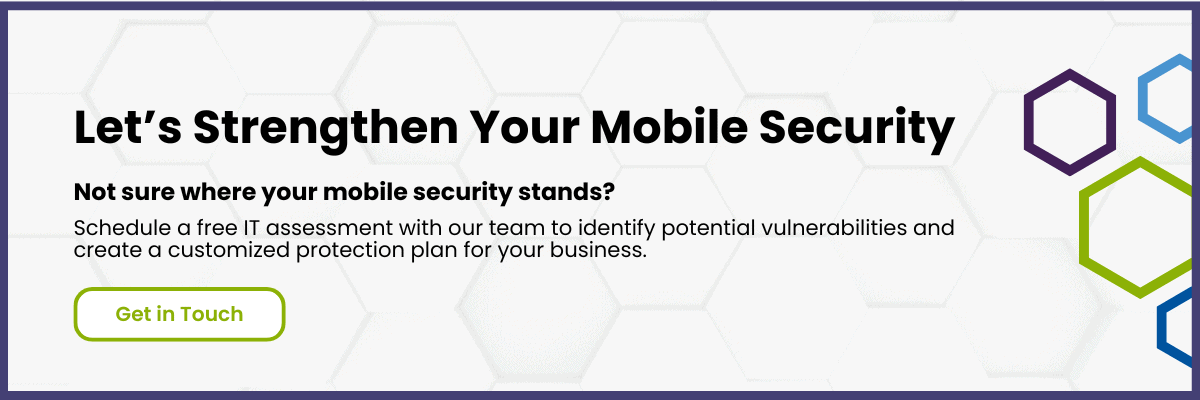The shift from desktop-only work environments to mobile-first business operations has transformed how we think about security. What once required physical access to a secure building now happens anywhere there’s a Wi-Fi signal. This change brings incredible benefits—but also creates new vulnerabilities that many businesses haven’t fully addressed.
How the Mobile Revolution Changed Everything
The transformation has been remarkable. We’ve moved from a world where sensitive business information lived exclusively on office computers to one where employees routinely access company email, customer databases, and financial systems from their smartphones and tablets. In fact, as many as 80% of IT executives say employees can’t do their jobs effectively without a mobile phone these days.
This mobility offers genuine advantages. Teams can respond to urgent client needs from anywhere. Sales representatives can access real-time inventory data while meeting with customers. Remote work becomes not just possible but productive and efficient.
However, each mobile device essentially becomes a potential entry point into your business network. Securing your business in this new landscape starts with understanding both the opportunities and the risks that mobile devices create.
The Hidden Risks of Mobile Business Use
Mobile devices present unique security challenges that traditional desktop security measures weren’t designed to handle. Because they develop gradually (and can remain invisible until a serious incident occurs), these risks often catch business owners off guard.
The most common mobile security risks include:
- Lost or Stolen Devices: Unlike desktop computers that remain anchored to desks, mobile devices travel everywhere your employees go. A smartphone left in a taxi or a tablet forgotten at a client meeting could contain years’ worth of business communications, customer contact information, and sensitive documents.
- Unsecured Wi-Fi Networks: Public Wi-Fi networks at airports, hotels, restaurants, and coffee shops operate without the security protocols you’d expect in your office environment. When employees connect to these networks—even quickly—to check email or access company systems, they’re potentially exposing business data to anyone else on the same network.
- App-Related Vulnerabilities: Similarly, mobile apps don’t always follow the same security standards as desktop software. Some apps request excessive permissions, store data insecurely, or contain vulnerabilities that cybercriminals can exploit. When employees download apps for both personal and business use on the same device, distinguishing between secure and risky applications becomes imperative.
- Outdated Operating Systems: Mobile operating systems receive regular security updates, but many users delay installing them or ignore update notifications entirely. These delays leave known vulnerabilities unpatched, creating opportunities for cybercriminals to gain unauthorized access to devices and the business data they contain.
Mobile Device Security Tips That Actually Work
Protecting your business in a mobile-first world requires practical strategies that your team will actually follow. Even the most sophisticated security measures become useless if they’re too complicated (or too time-consuming) for everyday use.
1. Implement Strong Authentication Practices
Multi-factor authentication should be non-negotiable for any business application accessed through mobile devices. This means requiring both a password and a second form of verification—such as a code sent to the user’s phone or generated by an authentication app.
Encourage employees to use device lock screens with PINs, passwords, or biometric authentication. While this might seem basic, many people still leave their devices completely unsecured. A locked device won’t prevent all security breaches, but it creates an important first barrier against unauthorized access.
2. Establish Clear App Installation Policies
Create guidelines about which apps employees can install on devices used for business purposes. Consider maintaining a list of approved business applications (while restricting the installation of apps from unknown developers or unofficial app stores).
Regular app audits help identify potentially problematic software before it becomes a security issue. Encourage employees to review the permissions requested by new apps and question whether those permissions are necessary for the app’s stated function.
3. Keep Everything Updated
Operating system updates often include critical security patches that address newly discovered vulnerabilities. Establish a policy requiring prompt installation of security updates, and consider enabling automatic updates where possible.
The same principle applies to business applications. App developers regularly release updates that fix security issues and improve protection against new threats, so even if you don’t notice any visible changes, keeping all software current reduces the window of opportunity for cybercriminals to exploit known vulnerabilities.
Best Practices for Mobile Device Use in Business
Just like in any area of cybersecurity, developing effective mobile security within a business takes more than just installing the right apps or configuring device settings. The most effective approach combines technology solutions with clear policies and ongoing education.
Create a Mobile Device Policy
A written mobile device policy eliminates confusion about expectations and responsibilities. Your policy should address:
- Device ownership guidelines (company-owned versus bring-your-own-device)
- Acceptable use standards for business purposes
- Required security settings and authentication methods
- Procedures for reporting lost or stolen devices
- Guidelines for connecting to public Wi-Fi networks
- App installation and approval processes
- Data storage restrictions and backup requirements
- Device sharing policies with family members or colleagues
Clear policies will help your employees make better security decisions in situations where professional support isn’t immediately available.
Implement Mobile Device Management (MDM)
Mobile device management solutions allow your IT administrators to remotely configure security settings, install approved applications, and even wipe data from lost or stolen devices. These tools provide centralized control over mobile security without requiring technical expertise from individual employees.
MDM solutions can also enforce password policies like these, restrict certain device functions, and ensure that business data remains separate from personal information on employee-owned devices. This separation protects both business confidentiality and employee privacy.
Train Employees on Mobile Security Awareness
Technical solutions work best when combined with human awareness. Regular training sessions help your employees recognize potential security threats and understand their role in protecting business information.
Focus training on practical scenarios employees actually encounter, for example:
- Identifying suspicious emails and text messages
- Recognizing fake Wi-Fi networks
- Understanding app permissions
- Knowing how to respond if they suspect their device has been compromised
Mobile Device Security Tips for Long-Term Success
Effective mobile security requires consistent application of security principles rather than one-time fixes. Regular training, policy updates, and technology reviews help maintain strong protection as both threats and technology continue to evolve.
Remember that mobile device security affects every aspect of modern business operations. From customer communications to financial transactions, mobile devices handle information that cybercriminals actively target. Implementing comprehensive best practices for mobile device use in business protects not just your data, but your reputation and customer relationships as well.
Are You 100% Confident in Your Mobile Device Security Strategy?
Our IT assessment can uncover vulnerabilities in five areas of security. Book yours now for an easy-to-understand report that drops all the tech jargon so you can see for yourself what’s really going on with your technology.





